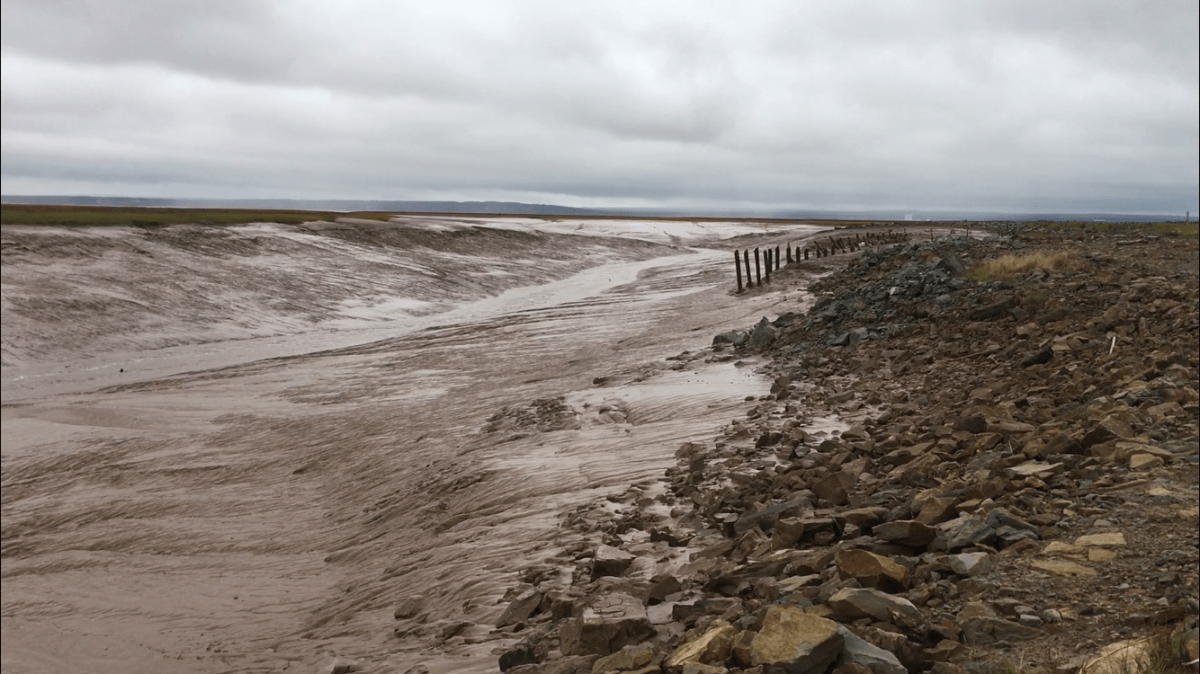Hurricane Dorian was a category one storm when it swept through the Maritimes at the beginning of September. The powerful storm caused damage across Nova Scotia, and while the storm itself cannot be pinpointed to climate change, the frequency of storms can.

In 2011, a study found that in the past 25 years the number of hurricanes and tropical storms has tripled.
As storms like Dorian become more common, there is one area that’s being considered especially vulnerable, the Chignecto Isthmus. It is described by the United Nations as one of the most vulnerable spots in North America for both the rising tide and storm surges.
READ MORE: Canadians want to stop climate change — but half don’t want to pay an extra cent: Ipsos poll
The isthmus is a 23km stretch of land that connects Nova Scotia to New Brunswick, and ultimately the rest of the country.
At the information centre on the Nova Scotia side of the border you can see the is Minas Basin, which is an arm of the Bay of Fundy.
“So there is not a lot of elevation between that water and where we are standing,” said Mayor of David Kogon at the information centre.
READ MORE: Canada positioned itself as a world leader on climate change — is it?
“Which is why this area is in such peril if there’s a storm surge, or if the sea level rise becomes more significant.”
Around the Chignecto Isthmus, sea levels are predicted to rise about a metre in the next eight decades. Currently, the area is protected by a system of dikes and aboiteaus, but the stability of the system is a concern.
John Atkinson is a farmer in the area. His family has owned marsh land for decades, but he has concerns about a dike along the LaPlance river that’s protecting his land.
READ MORE: Liberals pledge Canada will have net-zero emissions by 2050 — but details are scarce
He says the site of the old Amherst wharf has become a weak spot with erosion of the foreshore.
“Suddenly all of this land that used to be here just slumped down into the channel of the river,” he explained.

Get daily National news
Atkinson estimates about 50-60 feet of land has slid into the channel over the past few years.
One solution has been to bring in large rocks to help reinforce the land. Piles of rocks were placed along the foreshore two years ago, but they’ve already had to bring more in, with much of the original load getting sucked into the mud.
Dr. Jeff Ollerhead, a coastal geographer at Mount Allison University in Sackville says dikes require constant maintenance to be effective.
“Those dikes are constantly under pressure from both wave energy from strong tidal currents, and also ice and other debris banging into them,” he explained.
WATCH: ‘We’re not here to play politics about climate,’ says May

It’s a challenge for a region that relies on them.
“The agencies that are in charge of maintaining the dikes have to work with relatively small budgets for the amount of dikes they have to maintain,” said Ollerhead.
“So they have to strategically decide what to protect.”
But dikes can’t protect everything. One perfect storm could see the tide go over existing dikes and flood the area.
“It would have to be a storm that has winds that are more southerly than northerly,” said Ollerhead. It would also have to occur at just the right tide. A spring high tide would be the most damaging.
READ MORE: Canada won’t escape climate crisis, UN report says
“It’s not if it happens, it will happen, it’s just a statistically question of when,” said Ollerhead.
“It could happen next month or it could happen next year but equally it might not happen for 15 years.”
Already in the past 12 years conditions have been nearly perfect, but the storms weren’t during the highest tide.
“That was good fortune, that was good luck, that was not good management,” said Kogon, who worries about what could happen when that luck runs out.
“The impact on Nova Scotia would be enormous, you could technically cut off Nova Scotia from mainland Canada.”
And the impact would be felt beyond Nova Scotia. Each day truck and rail traffic transports $50 million in cargo through the Chignecto Isthmus, totaling $20 billion in trade annually. Losing that is a serious concern.
READ MORE: Scheer’s climate plan puts focus on ‘tech not taxes’ with $2.5B in pledges
It’s part of why the towns of Amherst Nova Scotia, and Sackville New Brunswick have joined together to fund a $700,000 study on how best to protect the region.
A request for a proposal was issued in July looking for “engineering analysis and feasibility assessment of potential solutions.” The RFP closed on August 30th and a contract is expected to be awarded shortly.
“Right now everybody is just waiting to see what is going to happen,” said Kogon.
“Our next step as municipal leaders is to make sure the options are acceptable to us as a municipality, not the cheapest, not the quickest but the best solution to our problem.”
Whatever is the solution the cost is expected to be in the millions, more than Sackville, Amherst and all of Cumberland County can afford without aid from other levels of governments.
“Whoever is in power needs to recognize that this is something that can’t be swept under the rug and overlooked and forgotten about,” said Atkinson.
WATCH: Isabelle Hurley talks about EnviroVote.ca









Comments